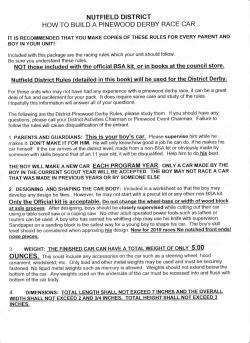
Austin Texas Championship Poster
Expanding the Genetic Code: Measurement Kit for the incorporation of non-canonical amino acids Alejandro Gutierrez, Jordan Monk, Catherine Mortensen, Nathan Shin, Ella Watkins. Advisors: Dennis Mishler, Ph.D. and Professor Jeffrey Barrick University of Texas at Austin, iGEM 2014 team: Austin_Texas Motivation and Background In recent years, the ability to expand the genetic code has been made possible by re-coding the amber stop codon, UAG, via the use of modified tRNA synthetase/tRNA pairs. The modified tRNA synthetase charges the modified tRNA with a non-canonical amino acid (ncAA), an amino acid that is not one of the 20 amino acids naturally encoded. Many different ncAA synthetase/tRNA pairs have been created, which allows for the introduction of novel functions into proteins. While numerous ncAA synthetase/tRNA pairs have been engineered, many are poorly characterized and may not specifically charge or not efficiently incorporate their ncAA. Measurement Kit Measuring Fluorescence The 4-Azidophenylalanine (AzF) pair shows high fidelity. The 3-Aminotyrosine (AminoY) pair shows poor fidelity. Incorporation Value (I) • A single value that indicates the efficiency and fidelity of a synthetase/tRNA pair. • The greater the value, the better the pair. • Controls (pFRYC) should be ~1. • Experimentals (pFRY) should be greater than 1. • A value less than 1 indicates low efficiency and/or toxicity. • 4 of the pairs tested are good! • 3 of the pairs tested are bad. • We created the Expanded Genetic Code Measurement Kit. Our kit can be used to quantify the fidelity and efficiency of any ncAA synthetase/tRNA pair. • We also used one of these ncAAs to create a system of lightactivated protein expression through Photocaged T7 RNAP. Methods The Expansion Pack Test Kit Plasmids GF P Lac O pFRYC pFRY La La Ge nt R Ka nR Control Strain Experimental Strain GF P P RF cI pStG Lac O Synthe tas e P RF cI tRNA Ka nR • pStG - tRNA synthetase/tRNA pair. • pFRYC - RFP-GFP reporter protein connected by a linker that does NOT contain an amber codon. • pFRY - RFP-GFP reporter protein connected by a linker that contains an amber codon (star). • The control strain contains pFRYC and pStG. • The RFP-GFP reporter should be produced in all conditions. ONBY: Photocaged T7 RNAP ortho-nitrobenzyl Tyrosine (ONBY) • ONBY can be used to photocage proteins. • The ONB group can be cleaved off with 365 nm light. Tyrosine ortho-nitrobenzyl Tyrosine (ONBY) Photocaged T7 RNA Polymerase (RNAP) 365 nm Light • The experimental strain contains pFRY and pStG. • Without ncAA, only RFP should be produced. • With ncAA, the RFP-GFP reporter should be produced. • Graphs show the amount of GFP fluorescence measured relative to RFP fluorescence. • Control GFP:RFP (pFRYC) is independent of ncAA. • Experimental GFP:RFP (pFRY) is dependent on the quality of the tRNA synthetase/tRNA pair and the presence of ncAA. Caged T7 RNAP mRNA Translation DNA Active T7 RNAP Protein These experiments are conducted in amberless E. coli, which have no amber codons in their genomes (Lajoie 2013). • ONBY can be incorporated at tyrosine 639 in T7 RNAP to prevent activity until decaged (Chou 2010). • Can be paired with any gene under the control of a T7 promoter. • Giving us spatiotemporal control over the transcription of that reporter via ONBY incorporation in T7 RNAP. Exposure *me Achievements • The 2014 UT Austin iGEM successfully created the Expanded Genetic Code Measurement Kit, including reporter plasmids in amberless E. coli. • Our system is inexpensive, portable, easy to use, and can quickly characterize numerous ncAA synthetase/tRNA pairs. • We characterized seven ncAA synthetase/tRNA pairs to demonstrate the quality of the system. • We successfully recreated a Photocaged T7 RNAP, demonstrating spatiotemporal control over reporter gene transcription. • We submitted BioBricks for two of the functional tRNA synthetase/tRNA pairs • Our Measurement Kit is now available to anyone who requests it. Temporal control of GFP expression using light-activated T7 RNAP. Spatial control of GFP expression using light-activated T7 RNAP. Special thanks to: Barrick Lab, Razan Alnahhas, Dr. Colin Brown, Michael J. Hammerling, Sean Leonard, and Ashley Kessel References: Chou, C., Young, D. D. and Deiters, A. (2010). Lajoie, M.J., Rovner, A.J., Goodman, D.B., et al. (2013). FUNDING FROM:
© Copyright 2025










